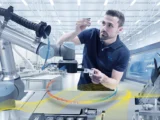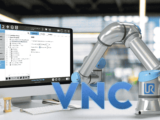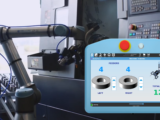Should I use VNC to control my robot remotely?
What is VNC?
VNC (Virtual Network Computing) is a desktop sharing system that allow to control a remote PC from another device. VNC is very useful to give technical support or take some action without being physically located where the technical assistance is needed. It’s not that different from other common remote desktop systems like TeamViewer or AnyDesk. So with VNC you can operate a remote factory PC from your office, from your home or maybe from the other side of the world.

So here comes the question: can I use VNC to control my robot remotely?
Robots and VNC
Technically, yes! Of course you can. Robots and cobots like Universal Robots have common Operating Systems running their software, so in many situations you could use VNC to connect and control the robot teach pendant remotely.
But if we look at this situation more carefully we can clearly see some dangerous drawback in this kind of approach: robots are not PC!
Controlling the robot remotely is a rather delicate issue for safety purposes: people near the robot could be harmed if someone else is controlling the robot remotely without notice.
You can check single simultaneous robot control point (ISO 10218) for more info about safety regulation.
Local and Remote Control Mode
To correctly manage this situation, robots often have a Local/Remote control mechanism which is implemented following safety standards.

For example, Universal Robots can be operated remotely only if Remote Control Mode is enabled by the local user. Only under this condition a remote user, which is not located near the robot and is not using the physical robot teach pendant, can run a program or move the robot. Local users have superior access rights with respect to Remote users, and at any time they can regain control of the robot and go back to Local Mode, preventing control from remote users.
Problems with VNC
What VNC actually does is bypassing all this safety mechanism. Using a VNC connection, remote users are controlling the robot actually as they were local user. Installing VNC on the robot controller breaks all safety mechanisms.
Remote Control Scenarios Compared
| ✅ Native Local/Remote Functions | ⚠️ VNC |
|---|---|
Remote control is enabled, the local user near the robot is alerted that someone else is controlling the robot. The remote operator moves the robot. The local operator sees that something is going wrong, so at any moment he kicks the remote user out (he goes back to local control mode) and restores the situation in manual and safe mode. This is how remote control is regulated by safety standards: the local person has superior access rights and must be able to regain exclusive control of the machine at any time. | Remote control is NOT enabled, the remote user controls the robot as if it were a local user via VNC. The local user has no evidence that anyone else is controlling the robot. The remote user moves the robot. The local operator sees that something is going wrong, tries to intervene, but can do nothing to stop the remote user who has the same access rights as him via VNC. The local user is in danger because he can be hit by the robot without being able to do anything to avoid it. |
From a legal point of view
Installing VNC on the robot has the same effect as tampering with a barrier, laser scanner or any other safety device. From a legal point of view, installing VNC can invalidate any safety certification that has been made on the machine following a risk assessment.
Everything is fine and everyone is happy… until somebody gets hurt.
Any other solutions?
At Robpod we have developed our Robpod Studio platform keeping all this in mind. Remote operation of Universal Robot is performed by our software following the Local/Remote mode safety mechanism. So a remote user can move the robot only when explicitly authorized with Remote Control mode enabled.
With Robot Studio you can mirror the robot teach pendant to view what’s happening on local site, give instructions to local users and operate the cobot in safe way.
Also you can take live screenshots of the UR teach pendant, which could be useful to create documentation and generate technical reports.
You can download Robpod Stuido here:
Find out more about UR Teach Pendant Viewer here:
https://docs.robpod.cloud/robot/robot-tool-window/teach-pendant-viewer
Get Started Now!
👨💻 Read the Docs




